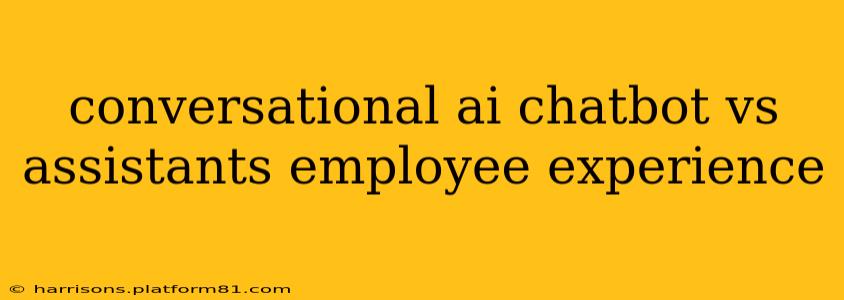The modern workplace is undergoing a significant transformation, driven largely by advancements in artificial intelligence (AI). One area experiencing this shift is employee support and communication, with conversational AI chatbots emerging as a powerful tool alongside – and sometimes in place of – traditional human assistants. This article delves into the comparison between these two approaches, examining their strengths and weaknesses in shaping a positive employee experience.
What are Conversational AI Chatbots?
Conversational AI chatbots are computer programs designed to simulate human conversation. Utilizing natural language processing (NLP) and machine learning (ML), they can understand and respond to employee queries in a natural, conversational manner. These chatbots are increasingly sophisticated, capable of handling a wide range of tasks, from answering basic HR questions to troubleshooting technical issues. They offer 24/7 availability, immediate responses, and consistent service delivery, all crucial aspects of a positive employee experience.
What are the Benefits of Using Chatbots for Employee Support?
The advantages of implementing conversational AI chatbots for employee support are substantial:
- Increased Efficiency and Productivity: Chatbots can handle a high volume of routine inquiries simultaneously, freeing up human assistants to focus on more complex and strategic tasks. This increased efficiency translates to cost savings and improved overall productivity.
- 24/7 Availability: Unlike human assistants, chatbots are available around the clock, providing immediate support whenever employees need it, regardless of time zone or workday hours. This is especially valuable for global teams or employees working unconventional schedules.
- Improved Employee Self-Service: Chatbots empower employees to find answers to their questions independently, reducing their reliance on human assistance for simple requests. This promotes autonomy and reduces wait times for support.
- Consistent and Accurate Information: Chatbots deliver consistent and accurate information based on pre-programmed knowledge bases. This eliminates inconsistencies that can arise from human error or differing interpretations of policies.
- Data-Driven Insights: Chatbot interactions provide valuable data on employee queries and pain points. This data can be analyzed to identify areas for improvement in processes, training, or communication.
How Do Human Assistants Contribute to Employee Experience?
While chatbots offer significant advantages, human assistants remain an essential component of a supportive and engaging employee experience. Their strengths lie in their:
- Empathy and Emotional Intelligence: Human assistants can understand and respond to the emotional needs of employees, providing personalized support and building stronger relationships. This is crucial when dealing with sensitive or complex issues that require a human touch.
- Problem-Solving and Critical Thinking: While chatbots excel at handling routine tasks, human assistants are better equipped to handle complex or unexpected situations requiring critical thinking and problem-solving skills.
- Building Community and Culture: Human interaction fosters a sense of community and connection within the workplace, contributing to a positive and engaging work environment. Chatbots cannot replicate this aspect of the employee experience.
- Personalized Guidance and Mentorship: Human assistants can provide personalized guidance, mentorship, and support, fostering employee growth and development in a way that chatbots cannot.
What are the Limitations of Chatbots in Employee Support?
Despite their many benefits, chatbots have limitations:
- Lack of Empathy and Emotional Intelligence: Chatbots struggle with understanding and responding to the emotional needs of employees, particularly in sensitive or stressful situations.
- Inability to Handle Complex or Unpredictable Issues: Chatbots are limited by their pre-programmed knowledge base and struggle with complex or unusual problems that require critical thinking and creative solutions.
- Potential for Impersonal Interactions: Over-reliance on chatbots can lead to impersonal interactions and a feeling of disconnection among employees.
- Technical Glitches and Errors: Chatbots can experience technical glitches or errors, leading to frustration and disruption for employees.
Can Chatbots and Human Assistants Work Together?
The most effective approach is often a blended model that leverages the strengths of both chatbots and human assistants. Chatbots can handle routine inquiries, freeing up human assistants to focus on more complex and emotionally demanding tasks. This collaborative approach optimizes efficiency while maintaining a human touch that is essential for a positive employee experience.
How to Choose Between Conversational AI Chatbots and Human Assistants?
The decision of whether to utilize chatbots, human assistants, or a combination of both depends on several factors:
- Budget: Implementing and maintaining chatbots requires an upfront investment, while human assistants incur ongoing salary and benefits costs.
- Volume of Inquiries: For high volumes of routine inquiries, chatbots are more efficient. For low volumes or complex issues, human assistants may be more suitable.
- Type of Inquiries: Chatbots are best suited for routine and easily answered questions, while human assistants are necessary for complex, sensitive, or emotionally charged issues.
- Company Culture: The company culture should influence the decision; some cultures may prioritize personalized human interaction, while others may favor efficient automation.
What are the Future Trends in Conversational AI for Employee Experience?
The future will likely see even more sophisticated conversational AI integrated into employee support. Expect advancements in:
- Improved NLP and ML: Leading to more natural and nuanced conversations with chatbots.
- Hyper-personalization: Chatbots will become more adept at tailoring their responses to individual employee needs and preferences.
- Integration with other systems: Seamless integration with HR systems, internal tools, and other platforms will provide employees with a more comprehensive and integrated support experience.
- Proactive support: Chatbots will be able to anticipate and address employee needs before they even arise.
In conclusion, the choice between conversational AI chatbots and human assistants is not an either/or proposition. A strategic blend of both, leveraging the strengths of each, offers the most promising path towards a superior employee experience – one that’s efficient, supportive, and engaging.
